stop start RENAULT LAGUNA 2012 X91 / 3.G Owner's Manual
[x] Cancel search | Manufacturer: RENAULT, Model Year: 2012, Model line: LAGUNA, Model: RENAULT LAGUNA 2012 X91 / 3.GPages: 241, PDF Size: 7.82 MB
Page 95 of 241
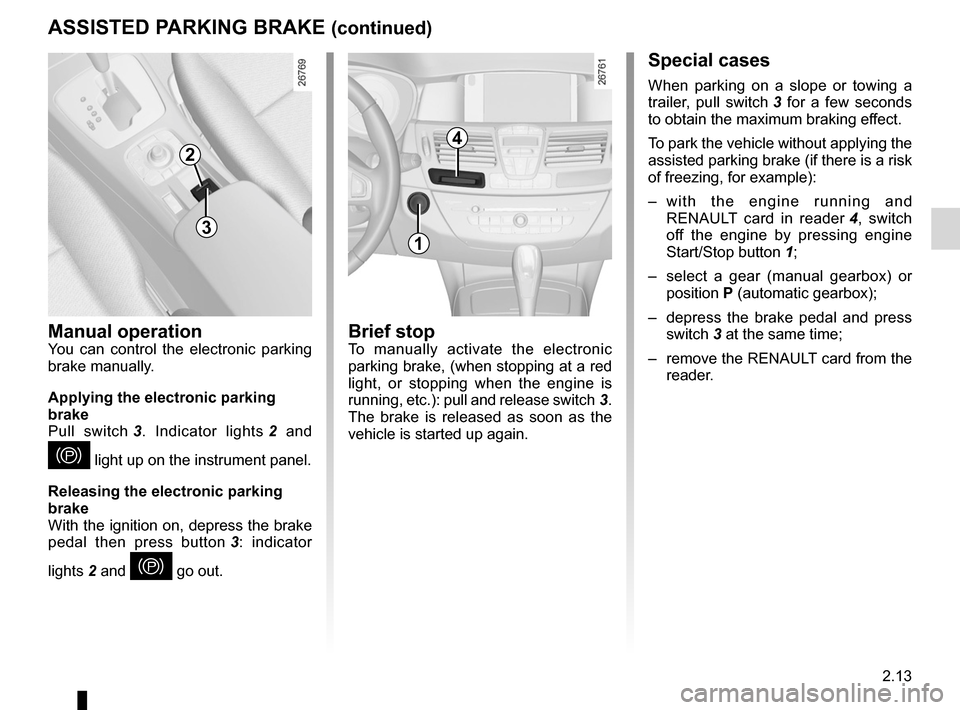
JauneNoirNoir texte
2.13
ENG_UD9635_3
Frein de parking assisté (X91 - B91 - K91 - Renault)
ENG_NU_936-5_BK91_Renault_2
Special cases
When parking on a slope or towing a
trailer, pull switch 3 for a few seconds
to obtain the maximum braking effect.
To park the vehicle without applying the
assisted parking brake (if there is a risk
of freezing, for example):
– w i t h t h e e n g i n e r u n n i n g a n d
RENAULT card in reader 4 , switch
off the engine by pressing engine
Start/Stop button 1;
– select a gear (manual gearbox) or
position P (automatic gearbox);
– depress the brake pedal and press
switch 3 at the same time;
– remove the RENAULT card from the
reader.
brief stopTo manually activate the electronic
parking brake, (when stopping at a red
light, or stopping when the engine is
running, etc.): pull and release switch 3.
The brake is released as soon as the
vehicle is started up again.
aSSISteD P aRkING bRake (continued)
4
13
Manual operationYou can control the electronic parking
brake manually.
applying the electronic parking
brake
Pull switch 3 . Indicator lights 2 and
} light up on the instrument panel.
Releasing the electronic parking
brake
With the ignition on, depress the brake
pedal then press button 3 : indicator
lights 2 and
} go out.
2
Page 98 of 241
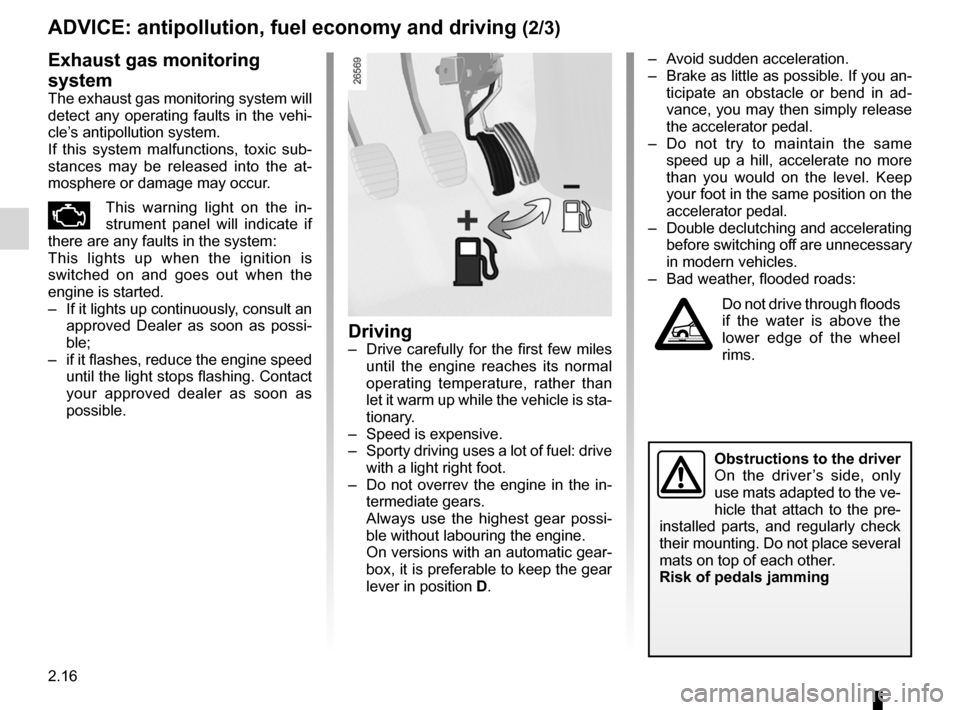
2.16
ENG_UD19886_6
Conseils antipollution, Ă©conomie de carburant, conduite (X45 - H45 - X85 - B85 - C85 - S85 - X91 - X83 - X61 - F61 - K61 - K85 - X95 - B95 - D95 - J95 - R95 - L38 - X61
ENG_NU_936-5_BK91_Renault_2
Jaune NoirNoir texte
aDvICe: antipollution, fuel economy and driving (2/3)
– Avoid sudden acceleration.
– Brake as little as possible. If you an-
ticipate an obstacle or bend in ad -
vance, you may then simply release
the accelerator pedal.
– Do not try to maintain the same
speed up a hill, accelerate no more
than you would on the level. Keep
your foot in the same position on the
accelerator pedal.
– Double declutching and accelerating
before switching off are unnecessary
in modern vehicles.
– Bad weather, flooded roads:
Do not drive through floods
if the water is above the
lower edge of the wheel
rims.
Driving– Drive carefully for the first few miles
until the engine reaches its normal
operating temperature, rather than
let it warm up while the vehicle is sta-
tionary.
– Speed is expensive.
– Sporty driving uses a lot of fuel: drive
with a light right foot.
– Do not overrev the engine in the in-
termediate gears.
Always use the highest gear possi -
ble without labouring the engine.
On versions with an automatic gear-
box, it is preferable to keep the gear
lever in position D.
exhaust gas monitoring
system
The exhaust gas monitoring system will
detect any operating faults in the vehi-
cle’s antipollution system.
If this system malfunctions, toxic sub -
stances may be released into the at -
mosphere or damage may occur.
Ă„This warning light on the in -
strument panel will indicate if
there are any faults in the system:
This lights up when the ignition is
switched on and goes out when the
engine is started.
– If it lights up continuously, consult an
approved Dealer as soon as possi -
ble;
– if it flashes, reduce the engine speed
until the light stops flashing. Contact
your approved dealer as soon as
possible.
obstructions to the driver
On the driver ’s side, only
use mats adapted to the ve-
hicle that attach to the pre-
installed parts, and regularly check
their mounting. Do not place several
mats on top of each other.
Risk of pedals jamming
Page 104 of 241

ABS ...................................................... (up to the end of the DU)
anti-lock braking system: ABS ..............(up to the end of the DU)
emergency brake assist ........................(up to the end of the DU)
emergency braking ............................... (up to the end of the DU)
driving ................................................... (up to the end of the DU)
ASR (traction control) ........................... (up to the end of the DU)
traction control: ASR .............................(up to the end of the DU)
traction control system: ASR ................(up to the end of the DU)
electronic stability control: ESC ............ (up to the end of the DU)
ESC: electronic stability control ............ (up to the end of the DU)
Hill Start Assist...................................... (up to the end of the DU)
2.22
ENG_UD27695_10
Dispositifs de correction et d’assistance à la de conduite (X91 - B91 - K91 - D91 - Renault)
ENG_NU_936-5_BK91_Renault_2
Jaune NoirNoir texte
abS (anti-lock braking
system)
Under heavy braking, the ABS prevents
the wheels from locking, allowing the
stopping distance to be managed and
keeping control of the vehicle.
Under these circumstances, the vehi -
cle can be steered to avoid an obstacle
whilst braking. In addition, this system
can increase stopping distances, par -
ticularly on roads with low surface grip
(wet ground etc.).
You will feel a pulsation through the
brake pedal each time the system is
activated. The ABS does not in any way
improve the vehicle's physical perform-
ance relating to the road surface and
roadholding. It is still essential to follow
the rules of good driving practice (such
as driving at a safe distance from the
vehicle in front etc.).
Driver correction devices and aids
DRIveR CoRReCtIoN DevICeS aND aIDS (1/5)
Depending on the vehicle, they may
comprise:
– t h e a bS ( a n t i - l o c k b r a k i n g
system);
– eSC (electronic stability program)
with understeer control and a SR
traction control;
– emergency brake assist with, de -
pending on the vehicle, braking
anticipation;
– rear wheel steering.
In an emergency, apply firm and
continuous pressure to the brake
pedal. There is no need to pump
it repeatedly. The ABS will modu -
late the force applied in the braking
system.
These functions are an ad-
ditional aid in the event of
critical driving conditions,
enabling the vehicle behav -
iour to be adapted to suit the driving
conditions.
However, the functions do not take
the place of the driver. they do
not increase the vehicle’s limits
and should not encourage you
to drive more quickly. Therefore,
they can under no circumstances
replace the vigilance or responsibil -
ity of the driver when manoeuvring
the vehicle (the driver must always
be ready for sudden incidents which
may occur when driving).
Yo u r b r a k i n g s y s t e m s
are partially operational.
However, it is dangerous
to brake suddenly and
it is essential to stop immediately,
as soon as traffic conditions allow.
Contact an approved dealer.
operating faults:
–
© and x lit up on the in -
strument panel alongside mes -
sages “Check ABS”, “Check braking
system” and “Check ESC”: indicates
the ABS, ESC and emergency brake
assist are deactivated. braking is
always enabled;
–
x, D, © and ® lit
up on the instrument panel alongside
the message “Braking system fault”:
this indicates a fault in the braking
system.
In both cases, consult an approved
dealer.
Page 105 of 241
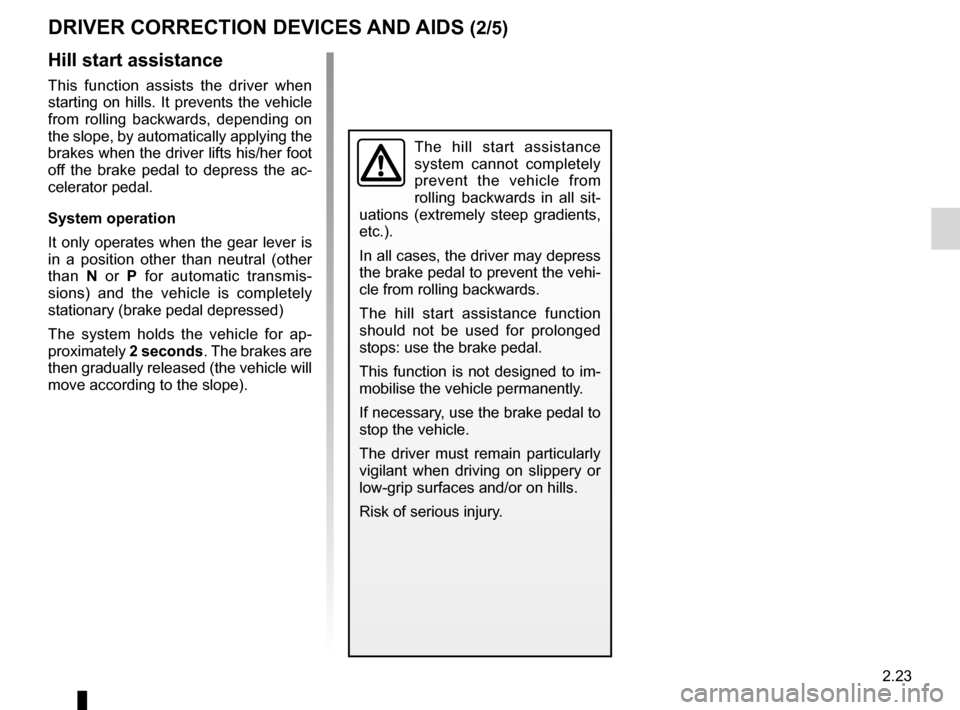
JauneNoirNoir texte
2.23
ENG_UD27695_10
Dispositifs de correction et d’assistance à la de conduite (X91 - B91 - K91 - D91 - Renault)
ENG_NU_936-5_BK91_Renault_2
DRIveR CoRReCtIoN DevICeS aND aIDS (2/5)
hill start assistance
This function assists the driver when
starting on hills. It prevents the vehicle
from rolling backwards, depending on
the slope, by automatically applying the
brakes when the driver lifts his/her foot
off the brake pedal to depress the ac -
celerator pedal.
System operation
It only operates when the gear lever is
in a position other than neutral (other
than N or P for automatic transmis -
sions) and the vehicle is completely
stationary (brake pedal depressed)
The system holds the vehicle for ap -
proximately 2 seconds. The brakes are
then gradually released (the vehicle will
move according to the slope).
The hill start assistance
system cannot completely
prevent the vehicle from
rolling backwards in all sit -
uations (extremely steep gradients,
etc.).
In all cases, the driver may depress
the brake pedal to prevent the vehi-
cle from rolling backwards.
The hill start assistance function
should not be used for prolonged
stops: use the brake pedal.
This function is not designed to im-
mobilise the vehicle permanently.
If necessary, use the brake pedal to
stop the vehicle.
The driver must remain particularly
vigilant when driving on slippery or
low-grip surfaces and/or on hills.
Risk of serious injury.
Page 120 of 241

2.38
ENG_UD27633_9
Boîte de vitesses automatique (X91 - B91 - K91 - D91 - Renault)
ENG_NU_936-5_BK91_Renault_2
Jaune NoirNoir texte
Parking the vehicle
When the vehicle is stopped, move the
lever to position P while keeping your
foot on the brake pedal: the gearbox is
in neutral and the drive wheels are me-
chanically locked by the driveshaft.
a pply the handbrake or, depending
on the vehicle, ensure that the elec-
tronic parking brake is applied.
Special circumstances
– If the road contours and bends
do not allow you to stay in auto -
matic mode (e.g.: in the mountains),
we recommend that you change to
manual mode.
This will prevent the automatic gear-
box from changing gears repeatedly
when climbing, and permit engine
braking on long descents.
– In cold weather , to prevent the
engine from stalling, wait a few mo-
ments before shifting the selector
lever from position P or N and en -
gaging D or R.
– vehicles not fitted with traction
control: on a slippery surface or
surface with a low level of adhe -
sion, change to manual mode and
select second gear before starting
the engine to avoid wheelspin when
starting.
Driving in manual mode
With the selector lever in position D,
move the lever to the left. Shifting the
lever repeatedly allows you to change
gears manually:
– To move down through the gears,
push the lever backwards;
– To move up through the gears, push
the lever forwards.
The gear selected is displayed on the
instrument panel.
Special cases
Under certain driving conditions (e.g.
engine protection, electronic stability
program (ESP) operational etc.: ESC),
the “automatic system” may change
gear automatically.
Likewise, to prevent incorrect manoeu -
vres, a gear change may be refused by
the automatic system: in this case the
gear display flashes for a few seconds
as a warning.
aUtoMatIC GeaRbox (2/3)
An impact to the underside
of the vehicle (e.g.: striking
a post, raised kerb or other
street furniture) may result
in damage to the vehicle (e.g.: de -
formation of an axle).
To avoid any risk of accident, have
your vehicle checked by an ap -
proved Dealer.
In very cold weather, the system
may prevent the gears from being
shifted in manual mode until the
gearbox reaches the right tempera-
ture.
Page 126 of 241

heating system ..................................... (up to the end of the DU)
air conditioning ..................................... (up to the end of the DU)
ventilation ............................................. (up to the end of the DU)
air conditioning ..................................... (up to the end of the DU)
3.4
ENG_UD12313_3
Chauffage / air conditionné (X91 - B91 - K91 - Renault)
ENG_NU_936-5_BK91_Renault_3
Jaune NoirNoir texte
Manual air conditioning/heating system
The controls
1 Air conditioning.
2 Air temperature.
3 Display.
4 Ventilation speed.
5 Distribution of air in the passenger
compartment.
6 De-icing/demisting of the rear screen
and, depending on the vehicle, the
door mirrors.
7 “Clear View” function.
8 Air recirculation.
Information and operating instruc -
tions: refer to the end of the paragraph. The arrows located in area
a on dis -
play 3 combine to show you the distri -
bution selected:
§The air flow is directed towards
the outlet located on the top of
the dashboard (position which allows
the greatest distribution of ventilation).
„the air flow is directed towards
the dashboard air vents (posi-
tion which allows the passenger com -
partment to be heated or cooled as
quickly as possible).
Ć’the air flow is directed mainly
towards the passenger foot -
wells.
‚the air flow is directed towards
the side window and wind -
screen demisting vents (position which
prevents condensation forming).
Stopping the systemPress the bottom of button 4 several
times to stop the system. To start, press
the top of button 4.
MANuAl AIR coNDITIoNINg/hEATINg SySTEM
7
8
1
2
3
4
5
6
a
Switching air conditioning on
or off
The air conditioning is switched on (in-
dicator light illuminated) or off (indicator
light extinguished) using button 1.
The air conditioning system is used
for:
– lowering the temperature inside the
passenger compartment;
– e l i m i n a t i n g c o n d e n s a t i o n m o r e
quickly.
The air conditioning does not operate
when the exterior temperature is low.
Adjusting the air temperatureUse control 2 to set the required tem -
perature. The more squares lit on the
display, the higher the temperature.
The fewer squares lit on the display, the
lower the temperature.
Distribution of air in the
passenger compartment
There are six air distribution options.
Press button 5 to scroll through them.
Page 128 of 241
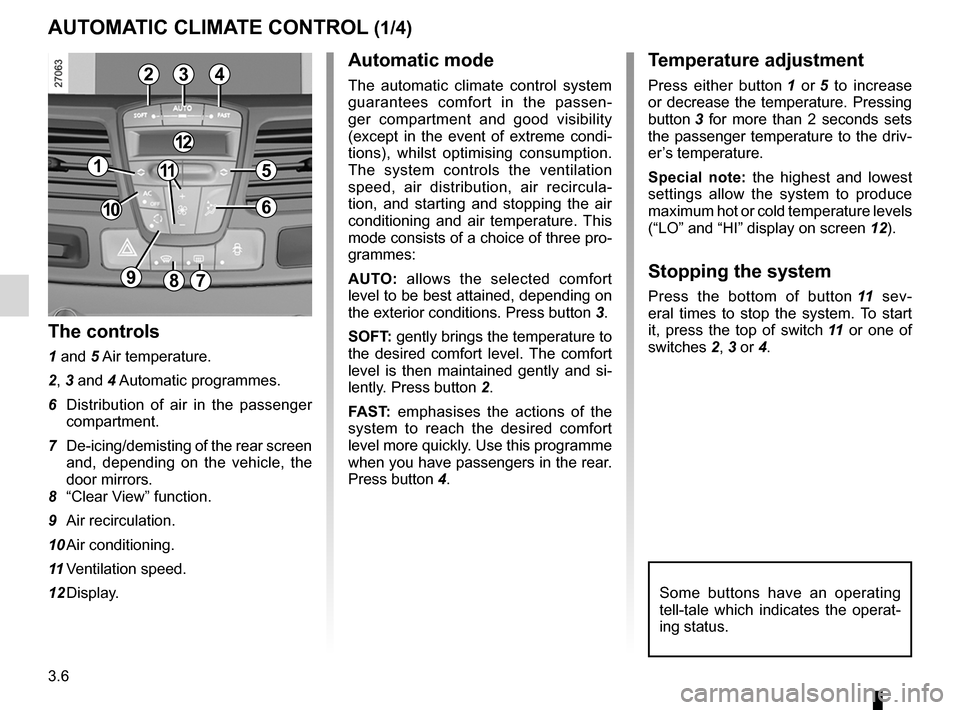
air conditioning ..................................... (up to the end of the DU)
heating system ..................................... (up to the end of the DU)
temperature regulation ......................... (up to the end of the DU)
ventilation ............................................. (up to the end of the DU)
air conditioning ..................................... (up to the end of the DU)
3.6
ENG_UD22215_6
Air conditionné automatique (X91 - B91 - K91 - Renault)
ENG_NU_936-5_BK91_Renault_3
Jaune NoirNoir texte
Automatic climate control
The controls
1 and 5 Air temperature.
2, 3 and 4 Automatic programmes.
6 Distribution of air in the passenger
compartment.
7 De-icing/demisting of the rear screen
and, depending on the vehicle, the
door mirrors.
8 “Clear View” function.
9 Air recirculation.
10 Air conditioning.
11 Ventilation speed.
12 Display.
Some buttons have an operating
tell-tale which indicates the operat -
ing status.
AuT oMATIc clIMATE coNTRol (1/4)
Automatic mode
The automatic climate control system
guarantees comfort in the passen -
ger compartment and good visibility
(except in the event of extreme condi -
tions), whilst optimising consumption.
The system controls the ventilation
speed, air distribution, air recircula -
tion, and starting and stopping the air
conditioning and air temperature. This
mode consists of a choice of three pro-
grammes:
A uTo : allows the selected comfort
level to be best attained, depending on
the exterior conditions. Press button 3.
SoFT: gently brings the temperature to
the desired comfort level. The comfort
level is then maintained gently and si -
lently. Press button 2.
FAST: emphasises the actions of the
system to reach the desired comfort
level more quickly. Use this programme
when you have passengers in the rear.
Press button 4.
9
10
111
6
12
23
5
4
8
Temperature adjustment
Press either button 1 or 5 to increase
or decrease the temperature. Pressing
button 3 for more than 2 seconds sets
the passenger temperature to the driv-
er’s temperature.
Special note: the highest and lowest
settings allow the system to produce
maximum hot or cold temperature levels
(“LO” and “HI” display on screen 12).
Stopping the system
Press the bottom of button 11 sev -
eral times to stop the system. To start
it, press the top of switch 11 or one of
switches 2, 3 or 4.7
Page 132 of 241
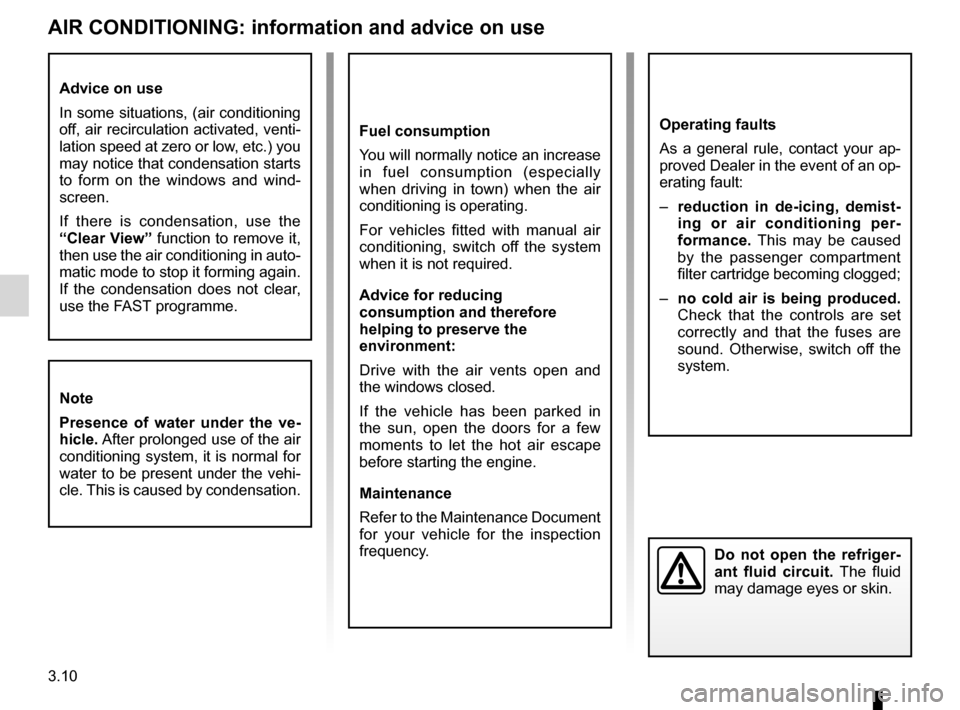
3.10
ENG_UD10081_2
Air conditionné : informations et conseils d’utilisation (X91 - B\
91 - K91 - Renault)
ENG_NU_936-5_BK91_Renault_3
Air conditioning: information and advice on use
AIR coNDITIoNINg: information and advice on use
Fuel consumption
You will normally notice an increase
in fuel consumption (especially
when driving in town) when the air
conditioning is operating.
For vehicles fitted with manual air
conditioning, switch off the system
when it is not required.
Advice for reducing
consumption and therefore
helping to preserve the
environment:
Drive with the air vents open and
the windows closed.
If the vehicle has been parked in
the sun, open the doors for a few
moments to let the hot air escape
before starting the engine.
Maintenance
Refer to the Maintenance Document
for your vehicle for the inspection
frequency.operating faults
As a general rule, contact your ap-
proved Dealer in the event of an op-
erating fault:
– reduction in de-icing, demist -
ing or air conditioning per -
formance. This may be caused
by the passenger compartment
filter cartridge becoming clogged;
– no cold air is being produced.
Check that the controls are set
correctly and that the fuses are
sound. Otherwise, switch off the
system.
Advice on use
In some situations, (air conditioning
off, air recirculation activated, venti-
lation speed at zero or low, etc.) you
may notice that condensation starts
to form on the windows and wind -
screen.
If there is condensation, use the
“clear View” function to remove it,
then use the air conditioning in auto-
matic mode to stop it forming again.
If the condensation does not clear,
use the FAST programme.
Do not open the refriger -
ant fluid circuit. The fluid
may damage eyes or skin.
Note
Presence of water under the ve -
hicle. After prolonged use of the air
conditioning system, it is normal for
water to be present under the vehi-
cle. This is caused by condensation.
Page 133 of 241

electric windows ................................... (up to the end of the DU)
child safety ............................................................. (current page)
children (safety) ..................................................... (current page)
sunroof .................................................. (up to the end of the DU)
3.11
ENG_UD23646_7
Lève-vitres électriques (X91 - B91 - K91 - Renault)
ENG_NU_936-5_BK91_Renault_3
Electric windows, electric sunroof
ElEcTRIc WINDoWS, ElEcTRIc SuNRooF (1/3)
These systems operate with the igni -
tion on or off, until the driver’s door is
opened (limited to about 5 minutes).
1
2
34
5
6
Electric windowsPress or pull the switch to raise or lower
a window to the desired height (the rear
windows do not open fully); Operate the
switches as follows:
1 for the driver’s window;
2 for the front passenger window;
3 and 5 for the rear windows.
From the passenger seats, use
switch 6. one-touch mode
Depending on the vehicle, this mode is
additional to the operation of the elec
-
tric windows. It may be fitted to the driv-
er’s window only, or to all the windows.
Briefly press or pull (fully) the window
switch: the window is fully lowered or
raised. Pressing the switch again stops
the window moving.
Note: if the window detects resistance
when closing (e.g. fingers, branch of
a tree, etc.) it stops and then lowers
again by a few centimetres.
Avoid resting any objects against a
half-open window: there is a risk that
the electric window winder could be
damaged.
Safety of rear occupants
Depending on the vehicle,
the driver can disable op -
eration of the electric win -
dows and the rear doors by press -
ing switch 4 . The indicator light
integrated in the switch lights up to
confirm that the locks have been ac-
tivated.
Driver’s responsibility
Never leave your vehicle with the
RENAULT card inside and never
leave a child (or a pet) unsuper -
vised, even for a short while. The
reason for this is that the child may
endanger himself or others by start-
ing the engine, activating equipment
such as the electric window, or lock-
ing the doors. If any part of the body
becomes trapped, reverse the di -
rection of the window immediately
by pressing the relevant switch.
Risk of serious injury.
Page 134 of 241

3.12
ENG_UD23646_7
Lève-vitres électriques (X91 - B91 - K91 - Renault)
ENG_NU_936-5_BK91_Renault_3
Jaune NoirNoir texte
ElEcTRIc WINDoWS, ElEcTRIc SuNRooF (2/3)
Sunroof
– open the blind
– To open slightly: turn button 9 to
position A;
– To open fully: turn button 9 to po -
sition B , C or D , depending on the
opening position required;
– To close: turn button 9 to position 0.
Sunroof blind
Only ever operate the blind with the
sunroof closed:
– to open: push handle 7 upwards
and guide the blind as it retracts;
– to close: pull handle 7 until it clicks
into the catch.
Special noteYour vehicle is equipped with an anti -
pinch facility: when the sunroof encoun -
ters resistance whilst closing, (some -
body’s fingers, etc.) it stops and then
moves back several centimetres.
– Never operate the sunroof with
the blind closed.
– Never drive with the sunroof open
and the sun blind closed.
7
0
ABc
D
98
Driver’s responsibility
Never leave your vehicle
with the RENAULT card
inside and never leave a
child (or a pet) unsupervised, even
for a short while. The reason for
this is that the child may endanger
himself or others by starting the
engine, activating equipment such
as the electric window, or locking
the doors. If any part of the body be-
comes trapped, reverse the direc -
tion of the window immediately by
pressing the relevant switch.
Risk of serious injury.